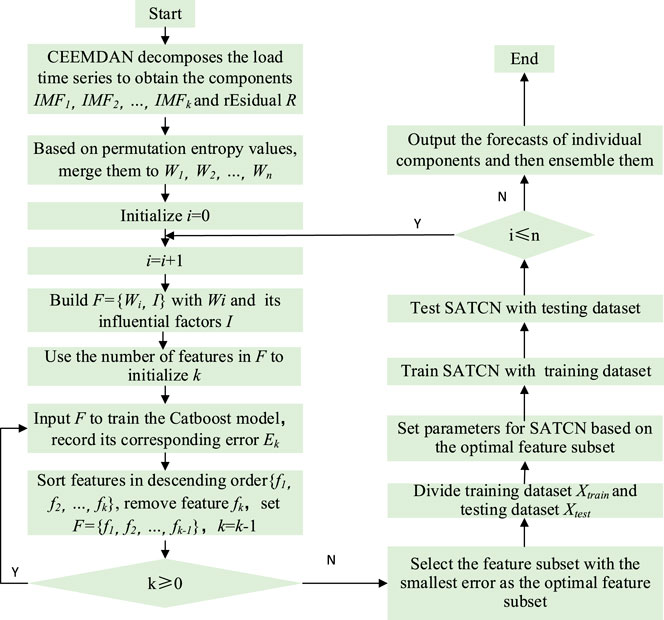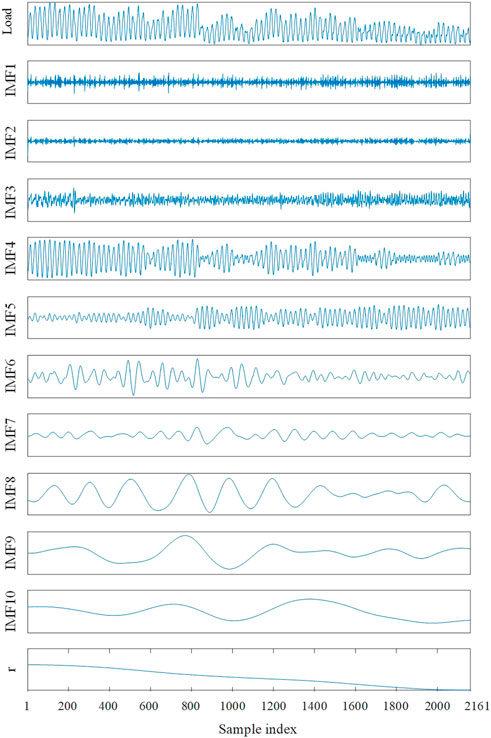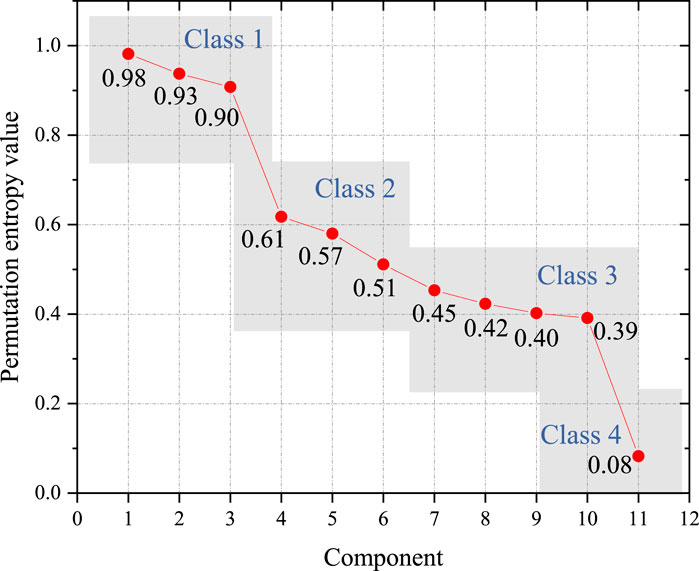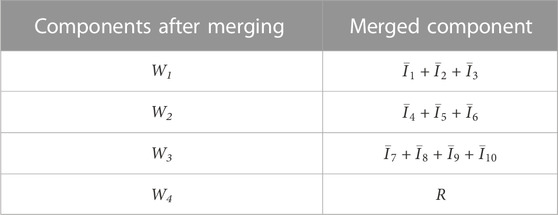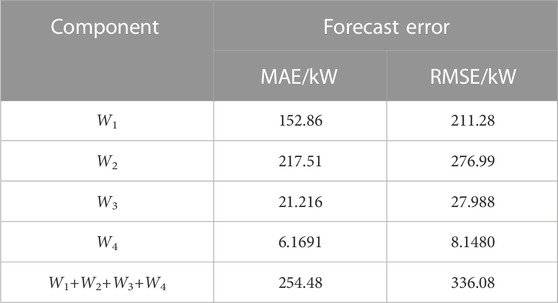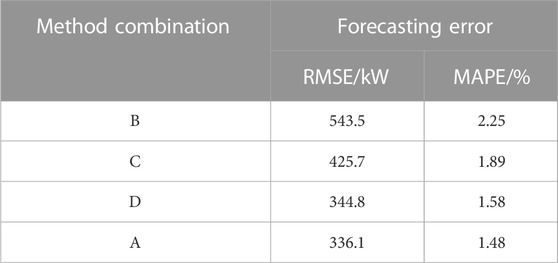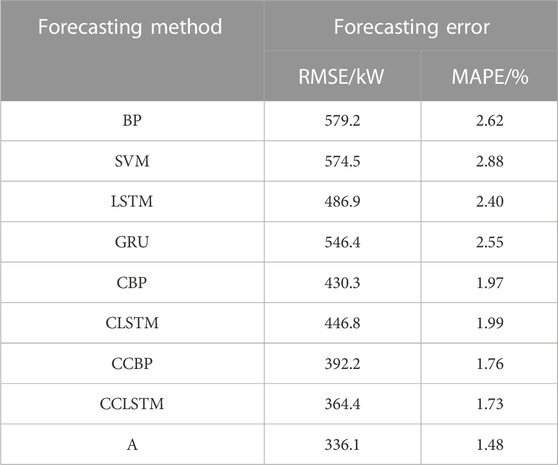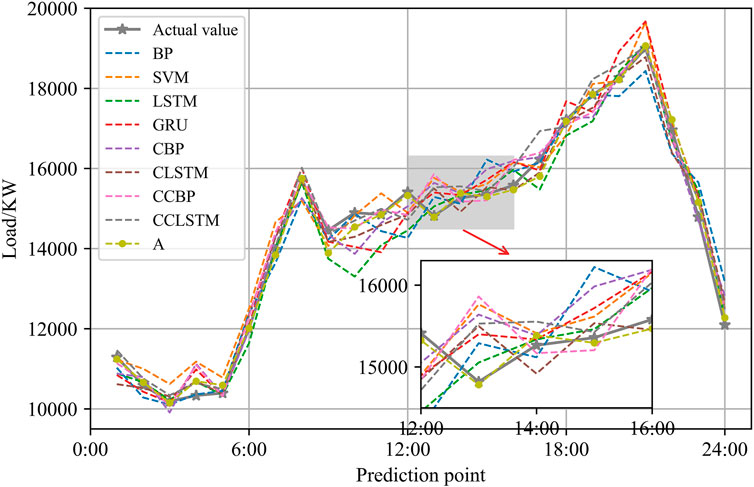- 1Economic Research Institute, State Grid Hebei Electric Power Co., Ltd., Shijiazhuang, China
- 2Science and Technology Department, State Grid Hebei Electric Power Co., Ltd., Shijiazhuang, China
- 3College of Electrical Engineering, Sichuan University, Chengdu, China
The rapidly increasing randomness and volatility of electrical power loads urge computationally efficient and accurate short-term load forecasting methods for ensuring the operational efficiency and reliability of the power system. Focusing on the non-stationary and non-linear characteristics of load curves that could easily compromise the forecasting accuracy, this paper proposes a complete ensemble empirical mode decomposition with adaptive noise–CatBoost–self-attention mechanism-integrated temporal convolutional network (CEEMDAN-CatBoost-SATCN)-based short-term load forecasting method, integrating time series decomposition and feature selection. CEEMDAN decomposes the original load into some periodically fluctuating components with different frequencies. With their fluctuation patterns being evaluated with permutation entropy, these components with close fluctuation patterns are further merged to improve computational efficiency. Thereafter, a CatBoost-based recursive feature elimination algorithm is applied to obtain the optimal feature subsets to the merged components based on feature importance, which can effectively reduce the dimension of input variables. On this basis, SATCN which consists of a convolutional neural network and self-attention mechanism is proposed. The case study shows that time series decomposition and feature selection have a positive effect on improving forecasting accuracy. Compared with other forecasting methods and evaluated with a mean absolute percentage error and root mean square error, the proposed method outperforms in forecasting accuracy.
1 Introduction
Aiming for carbon neutrality, developing distributed renewable energy-dominated energy systems has become an inexorable trend (Rehman et al., 2021; Li C et al., 2022). Together with the proliferation of electric vehicles and energy storage systems, this development trend has considerably increased the randomness and uncertainty of electrical loads, which has greatly increased the difficulty of short-term load forecasting (Deng et al., 2022). Therefore, developing accurate, fast, and effective short-term load forecasting methods has become an urgent demand for adapting to changes and promoting the development of emerging power systems.
Traditional machine learning methods represented by extreme learning machine (ELM), support vector machine (SVM), BP neural network, and random forest (RF) have been widely used in short-term load forecasting (Aasim et al., 2021; Huang et al., 2021; Xiao et al., 2022). With the rapid development of deep learning in the fields of computer vision, natural language processing, and speech recognition, recurrent neural networks represented by long short-term memory (LSTM) neural networks have been applied in the field of electrical load forecasting (Tan et al., 2020; Ge et al., 2021; Li S et al., 2022). Through time series modeling, electrical load statues over a period of time can be effectively perceived, achieving accurate identification of short-term load fluctuation patterns and long-term load change trends. However, when dealing with the input of an increasingly lengthening load time series, the dimension of the input layer, the number of layers, and the neurons of each layer continue to grow, resulting in difficulties in the training process and the issue of slow convergence. Based on the idea of time series modeling, the convolutional neural network (CNN) can be transformed into the temporal convolutional network (TCN) by making a node in the current layer which no longer depends on nodes that represent the previous time steps in the same layer but depends on those in the previous layer representing the previous time steps. This enables parallelizing the computing tasks of nodes that represent different time steps in the same layer. Independent parallel computing of large-scale convolution kernels can be realized, and the aforementioned problems can be effectively avoided (Luo et al., 2021). Hu et al. (2022) propose a quantile regression-integrated TCN to conduct electrical load forecasting. This model uses intervals to describe the probability distribution of future loads. Considering the influencing factors of load forecasting, Bian et al. (2022) use the temporal convolutional network to extract the potential association between time series data and non-time series data, then build time series features, and finally output the best load forecasts. Zhu et al. (2020) forecast the wind power output with the temporal convolutional network and compare the performance of LSTM and GRU. The result shows a higher forecasting accuracy of TCN.
Considering that various periodic fluctuation components hide in the original customer electrical load curves, time series decomposition methods such as empirical mode decomposition (EMD) and variational mode decomposition (VMD) can effectively help improve the accuracy of short-term load forecasting (Bedi and Toshniwal, 2018; Ye et al., 2022). However, some intrinsic mode components obtained by decomposition may have similar frequencies and fluctuation patterns. Exhaustively processing them all may result in an extra computational burden. Compared with the aforementioned methods, CEEMDAN can effectively improve the decomposition efficiency by adding auxiliary white noise to the original signal and solve the problems of a large reconstruction error and poor decomposition integrity of traditional methods (Zhang et al., 2017; Zhou et al., 2019). There are a lot of possible influencing factors to short-term load forecasting, but many of them are in fact redundant and irrelevant. Filter-based feature selection methods, such as those based on minimal redundancy maximal relevance (mRMR), can effectively reduce the feature dimension (Duygu, 2020; Yuan and Che, 2022) and thereby improve the efficiency of the subsequent training tasks. However, the mainstream filter-based feature selection methods merely assess the effect of individual features but are unable to assess the comprehensive performance of feature subsets. However, the CatBoost model uses combined category features to make use of the relationship between features, which greatly enriches feature dimensions, and it can realize the selection of the optimal feature set (Hancock and Khoshgoftaar, 2020; Mangalathu et al., 2020).
To this end, based on complete ensemble empirical mode decomposition with adaptive noise (CEEMDAN), CatBoost, and SATCN, this paper proposes a short-term load forecasting model. The original load time series is first decomposed into several intrinsic mode function (IMF) components and a residual with CEEMDAN. Then, permutation entropy values of them are calculated to determine which components should be merged for balancing the forecasting accuracy and the computational efficiency. The CatBoost-based recursive feature reduction method is applied to optimize the input feature set of individual components. A self-attention mechanism-integrated temporal convolutional network (SATCN) model that integrates CNN and the self-attention mechanism is then trained to output forecasts corresponding to the components. At last, the forecasts are combined to generate the short-term load forecast.
2 Decomposition of the load time series
2.1 Complete ensemble empirical mode decomposition with adaptive noise
CEEMDAN obtains IMF components by adding multiple adaptive Gaussian white noise sequences and averaging the decomposition results from EMD. The unique residual calculation method of CEEMDAN endows integrity to the decomposition process, which not only mitigates the inherent mode-mixing phenomenon of the existing EMD but also considerably reduces the signal reconstruction error, making the reconstructed signal almost identical to the original one (Chen et al., 2021).
This paper uses
The steps of the CEEMDAN algorithm are as follows:
2.2 Permutation entropy of the load time series
The complexity of a time series can be measured by the time series permutation entropy (Zhao et al., 2022), which will be used as the basis for component merger and reorganization. For enough a number of components, when their permutation entropy values are close, the correspondingly indicated fluctuation patterns of the load time series are similar. Therefore, these components can be merged and reorganized to reduce the computational burden for the subsequent forecasting task. Considering a one-dimensional load time series
This paper first sorts the reconstructed row vectors in
For any row vector
3 CEEMDAN-CatBoost-SATCN-based ensemble forecasting method
3.1 Feature selection with CatBoost algorithm
As one of the three mainstream machine learning algorithms in the family of boosting algorithms (Jiang et al., 2020), like XGBoost (Zhang et al., 2020) and light gradient boosting machine (LightGBM) (Ma et al., 2018), CatBoost is an improved gradient boosting decision tree (GBDT)-based algorithm. Each time CatBoost builds a regression tree, it uses the residual information of the previous regression tree and builds in the direction of gradient descent. However, different from GBDT, by adopting oblivious trees as base predictors, CatBoost can obtain an unbiased estimate of the gradient to avoid overfitting. During the training process, CatBoost learns and explores patterns from the samples generated by the previous regression tree and changes the weights of the subsequent regression tree, so that the regression tree with a larger residual error has a higher weight. Finally, the idea of ensemble learning is applied to combine multiple weak learners to constitute a learner with a strong learning ability.
CatBoost assesses the feature importance during the training process, with which a variety of feature selection strategies can indeed be built. A prediction value change (PVC) indicates the average fluctuation of the predicted value from the CatBoost model responding to the unit change of a feature. This is shown in Eqs 10 and 11, where Wl and Vl denote the weight and the target value of the left leaf, respectively; and Wr and Vr denote the weight and the target value of the right leaf, respectively. The loss function change (LFC), as in Eq. 12, indicates the value change of the CatBoost model’s loss function with and without a certain feature and reflects the effect of including a certain feature in accelerating the model convergence. In Eq. 12, X represents the input feature set that consists of N features and Xi indicates the set of remaining features with feature i being removed from X. Naturally, it contains N-1 features.
This paper selects the optimal features with a greedy strategy in a recursive feature reduction process. The main idea is to repeatedly construct CatBoost models and then identify and remove the least important features. The detailed steps are as follows:
3.2 Self-attention mechanism-integrated TCN forecasting model
Learning from the attention and cognitive function of human brains, the self-attention mechanism (Cao et al., 2021) selectively focuses on learning and memorizing certain input information, thereby solving the problem of information overload caused by a large amount of input, effectively improving the training efficiency, and enhancing the prediction performance. For an input matrix
TCN is mainly composed of two parts, namely, causal convolution and dilated convolution, in which the former accomplishes causal modeling relying on time dependency and avoiding involving the information from the future and the latter allows input sequences to have time intervals and achieves exponential expansion of the receptive field with the same number of convolution layers. Given the input sequence and the convolution kernel, the output of the hidden layer at the ith time step with the dilated convolution can be represented as
where K is the size of the convolution kernel, d is the dilation rate, f(j) is the jth element in the convolution kernel, and xi-d·j is the element in the input sequence that corresponds to the jth element in the convolution kernel.
In short-term load forecasting, by integrating the self-attention mechanism into TCN, the correlation between the load time series and influencing factors such as weather, temperature, and climate can be effectively captured. Moreover, the influence of key influencing factors is highlighted, which helps improve the final forecasting accuracy. Therefore, this paper further improves the traditional TCN and proposes the SATCN as shown in Figure 1.
3.2.1 Temporal convolutional network layer
The first layer connected to the input layer is a TCN layer, which takes the multi-dimensional time-correlated load time series,
3.2.2 Convolutional neural network layer
The second layer is the CNN layer, which takes the hidden states’ output by the previous layer of TCN as the input. Leveraging the powerful feature compression and extraction capability of CNN, this layer realizes the feature recognition and extraction of the hidden states and finally outputs time series patterns
where the subscript i represents the ith convolution layer, the subscript j represents the jth convolution kernel, and the subscript l represents the lth position in the convolution kernel.
3.2.3 Self-attention mechanism layer
The third layer is the self-attention mechanism layer. First, applying the linear transformation as in Eqs 13, 14, 15, the time series features extracted by the CNN layer can be mapped to matrices Q, K, and V, and then the feature matrix Y can be calculated with a scaled dot-product attention mechanism as in Eq. 16. At last, the load forecast yt+1 for the t+1 time step is output through a fully connected layer.
3.3 The proposed ensemble forecasting method
This paper first adopts CEEMDAN to decompose the load time series to obtain the mode components
4 Case study
4.1 Dataset
Real electrical load data from a certain area are adopted in this paper. The dataset includes 90 days of electrical load data and related data of influencing factors from 5 July 2004 to 2 October 2004. The data granularity is hourly, i.e., 24 samples a day. Historical load, real-time temperature, time, week, month, and holiday form the input feature set as shown in Table 1. For categorical features, such as week and month, they need to be quantified into numerical values to be seamlessly input into the model. To this end, we represent hours from 0:00 to 24:00 as integers {0, 1, .., 23}, Monday to Sunday as integers {1, 2, .., 7}, and months from January to December as integers {1, 2, .., 12}. Holidays are represented as binaries {0, 1}, where 1 means that the day is a holiday; otherwise, 0. For numerical features such as load and temperature, this paper directly uses the data. Considering that the components of the load time series fluctuate periodically in days, the length of the historical load should be a multiple of one day. In this paper, 7-day historical load is selected as the input. In addition, since the time effect of temperature on the load is relatively obvious, this paper selected the temperature data of the previous 6 hours as the input.
4.2 Performance evaluation
We use the mean absolute error (MAE), mean absolute percentage error (MAPE), and root mean square error (RMSE), as defined in Eqs 20, 21, 22, respectively, to evaluate the short-term load forecasting accuracy. In Eqs 20, 21, 22,
MAPE can eliminate the absolute difference between forecasting errors at different forecasting time steps by giving them the same weight, which makes MAPE highly interpretable. However, as the IMF component Wi obtained by decomposition is close to a sinusoidal curve that periodically crosses zero, when the actual value is zero or close to 0 at the forecasting time step, the MAPE will have an extremely high value causing overestimation of the forecasting error. This is because the denominator in Eq. 21 is close to 0. To this end, in the subsequent feature selection process with CatBoost, this paper uses MAE and RMSE only to evaluate the forecasting error of different feature subsets with different numbers of features.
4.3 Experimental results
4.3.1 Load time series decomposition with CEEMDAN
In the load time series decomposition with CEEMDAN, through multiple experiments, this paper sets the standard deviation of the white noise at 0.25 and generates white noise sequences 100 times. The maximum number of iterations is set to 5,000, and the results are shown in Figure 3.
It can be seen from Figure 3 that 11 CEEMDAN IMF components are obtained by CEEMDAN. The inherent mode mixing of each IMF component is evaluated with permutation entropy, and those close IMF components are merged and reorganized. Through multiple experiments, we set τ at 1 and L at 3. The permutation entropy value of each IMF component is shown in Figure 4.
From Figure 4, permutation entropy values can be clustered into three classes. The first class contains IMF components 1, 2, and 3, whose permutation entropy values are all above 0.9. Their maximum internal distance is only 0.08, while their lowest value has a distance of 0.3 to the second class. The second class contains IMFs 4–10. Their permutation entropy values are generally evenly distributed, and the descent rate gradually decreases. The third class only contains the residual component, and its permutation entropy value is only 0.08, indicating that its fluctuation pattern is extremely monotonous. This well matches the actual monotonically decreasing pattern shown in Figure 3. As the second class contains more IMF components than expected, in order to improve the overall forecasting accuracy, we further divide this class into two classes. Finally, the first divided class includes IMF components 4, 5, and 6, and the internal distance is 0.1; the second divided class includes IMF components 7, 8, 9, and 10, with an internal distance of 0.06. The final CEEMDAN IMF component merger results are shown in Table 2.
Considering that the components of different fluctuation frequencies have different requirements on the model fitting ability, an appropriate network structure should be designed to avoid overfitting or underfitting and effectively improve forecasting accuracy.
4.3.2 Feature selection with CatBoost
The merged components Wi, the load combination LT-n, temperature Tt-n, and date together constitute the original feature set F, which is input into the CatBoost gradient boosting tree. The CatBoost model is then trained. According to Eq. 10, the feature importance of individual features in F is calculated, and then these features are sorted in descending order with respect to their importance. The number of features k, the feature set F, EMAE, and ERMSE on the test set are recorded. Then, the feature with the lowest importance is removed from F realizing the feature reduction. This process is repeated until F becomes empty. Thereafter, the mapping between the number of input features in each component Wi and the forecasting errors, EMAE and ERMSE, can be established. The results are shown in Figure 5. First, the number of features corresponding to the minimum point of the EMAE curve is selected as the optimal feature under the EMAE index, as shown in the orange label in Figure 5; Second, the number of features corresponding to the minimum point of the ERMSE curve is selected as the optimal feature under the ERMSE index, as shown in the blue label in Figure 5. Finally, in order to improve the feature reduction rate and improve the forecasting efficiency, in this paper, the smaller value of EMAE and ERMSE is adopted to indicate the optimal feature subset.
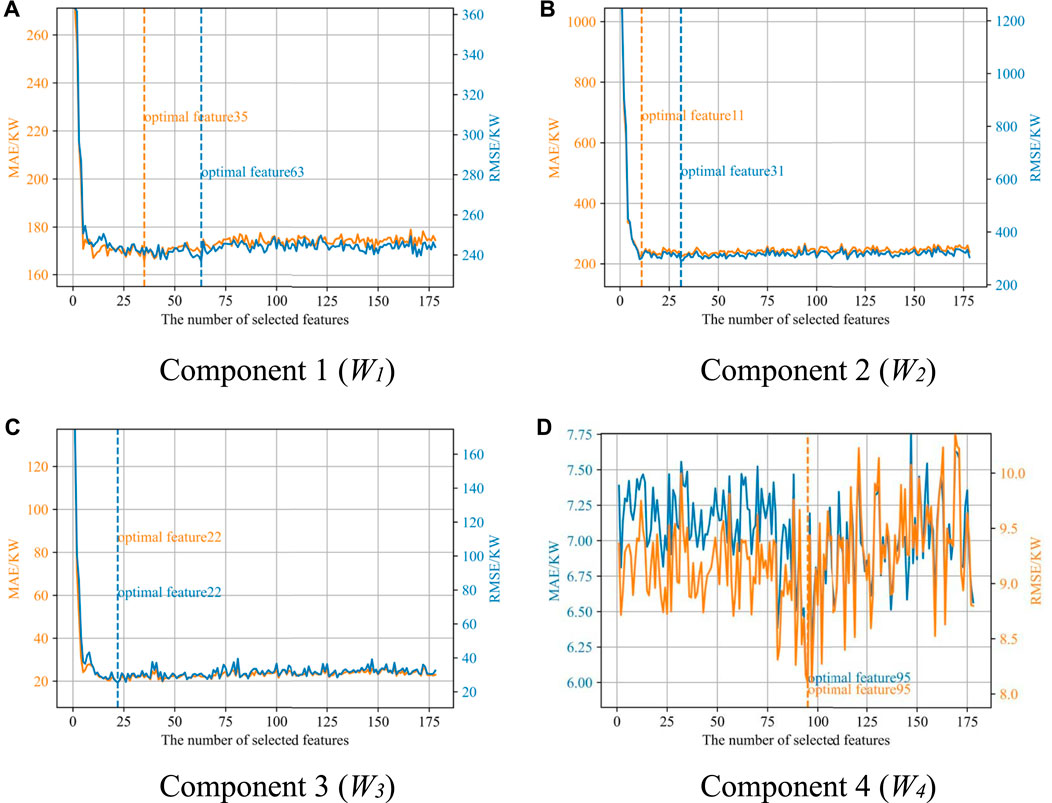
FIGURE 5. Forecasting errors with different numbers of input features for four components as examples including (A) Component 1, (B) Component 2, (C) Component 3, and (D) Component 4.
It can be seen from Figure 5 that the numbers of features in the optimal feature subsets for each component are, respectively, 35, 11, 22, and 95, and the corresponding feature reduction rates are 80.3%, 93.8%, 87.6%, and 46.6%. Generally, with the increase in the number of input features, the forecasting error first decreases greatly. Then, it gradually stabilizes and fluctuates within a small range.
The optimal value appears with a certain number of features, indicating that there are key factors affecting load forecasting accuracy. Therefore, as long as those key features are selected, relatively high forecasting accuracy can be achieved. In addition, it shows that feature selection can effectively identify the importance of different features so that redundant features and noise features can be removed to achieve dimension reduction of the input as well as training efficiency improvement. Indeed, for different components, more adaptive forecasting algorithms, models, and input structures can be designed to capture their fluctuation patterns, and the TCN with the self-attention mechanism can be applied to capture their change trends in a period of time.
4.3.3 Forecasting with the self-attention mechanism-integrated temporal convolutional network
After the optimal feature subset of each component Wi is determined, selected features will be input into the SATCN model. The optimal hyperparameters are determined with a grid search. The dataset is randomly divided into Xtrain, Xvalidation, and Xtest with the ratio of 8:1:1. Xtrain is input into SATCN and processed sequentially by the input layer, the TCN layer, the CNN layer, the self-attention layer, and the output layer. Finally, the forecast Yp is output. The loss function value Eloss of Yp and label YT are then calculated. This paper uses Adam optimizer to realize backpropagation and update the weight W and bias b in the SATCN. This process is repeated until the Eloss of SATCN decreases slowly on Xtrain or ERMSE that no longer decreases on Xvalidation, and this paper considers that SATCN has converged. Forecasts Yp are obtained by inputting Xtest to the trained SATCN. The summation of Yp over components Wi gives the final forecast. The corresponding errors, EMAPE and ERMSE, are calculated with Eq. 20 and 21, respectively. The results are shown in Table 3.
By setting the forecasting time steps at 24 consecutive hours of a day, the forecasting performance of individual components with the proposed CEEMDAN-CatBoost-SATCN-based method is shown in Figure 6.
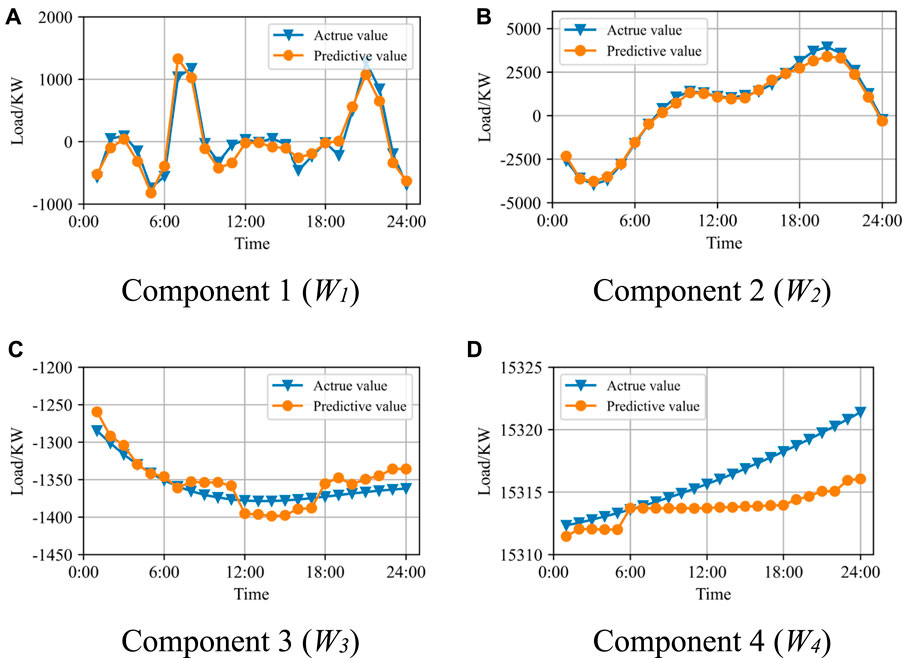
FIGURE 6. Forecasting performance of the proposed CEEMDAN-CatBoost-SATCN method with four components as examples including (A) Component 1, (B) Component 2, (C) Component 3, and (D) Component 4.
It can be seen from Table 3 and Figure 6 that for every component, EMAE is lower than 65 KW and ERMSE is lower than 85 KW, which indicates a high accuracy in short-term load forecasting.
4.3.4 Effectiveness of CEEMDAN and CatBoost
To verify the accuracy and efficiency of the proposed method combination of CEEMDAN-CatBoost-SATCN (denoted as method combination A), this paper compares it with SATCN (method combination B), CatBoost-SATCN (method combination C), and CEEMDAN-SATCN (method combination D). The single-time step-forecasting errors, RMSE and MAPE, are shown in Table 4, and the running time scatter diagram is shown in Figure 7.
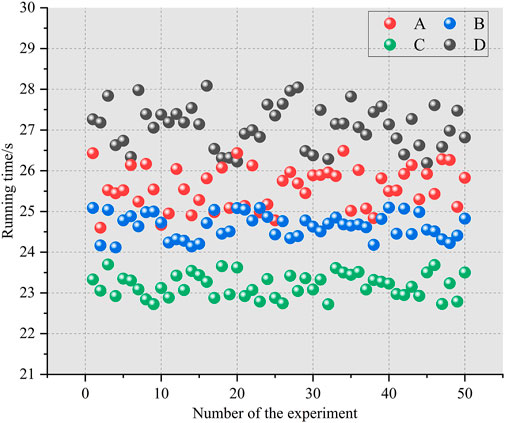
FIGURE 7. Scatter chart of running time of (A) CEEMDAN-CatBoost-SATCN, (B) SATCN, (C) CatBoost-SATCN, and (D) CEEMDAN-SATCN methods.
It can be seen from Table 4 that compared with method combination B of direct load forecasting, method combination C reduces RMSE by 21.6% and MAPE by 16%, indicating that the feature selection method can effectively improve the subsequent forecasting accuracy. CEEMDAN-based method combination D reduces RMSE by 36.5% and MAPE by 29.7%, indicating that CEEMDAN that decomposes the load time series and enables separate forecasting on components can also improve the forecasting accuracy. Compared with method combinations B, C, and D, the proposed combination, namely, method combination A, has the lowest RMSE and MAPE, which means the combination of time series decomposition and feature selection has a positive effect on improving the accuracy of short-term load forecasting.
It can be seen from Figure 7 that compared with method B, CEEMDAN has increased the complexity of model calculation and model running time due to time series decomposition, while CatBoost reduces the number of input features through feature optimization, which improves the computational efficiency. The method used in this paper combines CEEMDAN, CatBoost, and SATCN, and on the premise of significantly improving the prediction accuracy, the additional running time cost is not large.
4.3.5 Effectiveness of CEEMDAN and CatBoost
To verify the effectiveness of the proposed method in this paper, this paper compares it with BP, SVM, LSTM, GRU, and their combined methods including CEEMDAN-LSTM (CLSTM), CEEMDAN-BP (CBP), CEEMDAN-CatBoost-BP (CCBP), and CEEMDAN-CatBoost-LSTM (CCLSTM). Their performances are evaluated with MAPE and RMSE. The optimal hyperparameters of these methods are determined through multiple experiments. The single time step-forecasting errors, EMAPE and ERMSE, of the aforementioned models are shown in Table 5, and their forecast errors of 24-hour forecasting are shown in Figure 8.
It can be seen from Table 5 that CBP, which integrates the CEEMDAN based on BP, reduces ERMSE and EMAPE, respectively, by 25.7% and 24.8% compared with BP. CCBP that integrates CEEMDAN and CatBoost further reduces ERMSE and EMAPE by 8.8% and 10.6%, respectively, compared with CBP. Similarly, on the basis of LSTM, CLSTM reduces ERMSE and EMAPE by 8.2% and 17%, respectively; and on the basis of CLSTM, CCLSTM reduces ERMSE and EMAPE by 18.4% and 13.1%, respectively. This shows that CEEMDAN and CatBoost are effective in multiple forecasting models. Compared with CCBP and CCLSTM, the forecasting errors of the method proposed in this paper are smaller, which means SATCN proposed in this paper has a better forecasting performance than LSTM and BP. Moreover, compared with other forecasting methods, the method proposed in this paper has the lowest ERMSE and EMAPE. From Figure 8, it can be seen that in off peak load and off valley load periods, namely, from 13:00 to 15:00, the forecasting error of the proposed method is smaller compared with that in other periods.
5 Conclusion
A short-term load forecasting model considering time series decomposition and feature selection is proposed. The experimental results show that the forecasting accuracy can be effectively improved compared to traditional methods by separately selecting optimal features, building forecasting models, and finally combining the separate forecasting results with respect to the obtained components through CEEMDAN. The recursive feature selection method based on the CatBoost gradient boosting regression tree can effectively evaluate the importance of different features and remove redundant and noise features. The SATCN, integrated with the CNN and self-attention mechanism, has a strong ability to capture load time series features and explore multi-dimensional variable associations. Compared with other forecasting methods, the proposed CEEMDAN-CatBoost-SATCN-based forecasting model can accurately identify the fluctuation pattern of the load and outperform in terms of forecasting accuracy.
Data availability statement
The original contributions presented in the study are included in the article/Supplementary Material; further inquiries can be directed to the corresponding author.
Author contributions
YW, ZZ, and NP proposed the idea of the study. YW, ZZ, NP, ZS, and LX implemented the algorithms and analyzed the experimental results. All authors participated in the writing of the manuscript.
Funding
This work was supported by the funds of the Economic Research Institute of State Grid Hebei Electric Power Co. Ltd., under the Project “Optimal allocation of demand side resources based on high-dimensional spatio-temporal data under grid user two-way interaction (SGTYHT/20-JS-221).”
Conflict of interest
Authors YW, ZZ, NP, ZS, and LX were employed by the company State Grid Hebei Electric Power Co., Ltd.The authors declare that this study received funding from Economic Research Institute of State Grid Hebei Electric Power Co. Ltd.
The remaining authors declare that the research was conducted in the absence of any commercial or financial relationships that could be construed as a potential conflict of interest.
Publisher’s note
All claims expressed in this article are solely those of the authors and do not necessarily represent those of their affiliated organizations, or those of the publisher, the editors, and the reviewers. Any product that may be evaluated in this article, or claim that may be made by its manufacturer, is not guaranteed or endorsed by the publisher.
Supplementary material
The Supplementary Material for this article can be found online at: https://www.frontiersin.org/articles/10.3389/fenrg.2022.1097048/full#supplementary-material
References
AasimSingh, S. N., and Mohapatra, A. (2021). Data driven day-ahead electrical load forecasting through repeated wavelet transform assisted SVM model. Appl. Soft Comput. 111, 107730. doi:10.1016/J.ASOC.2021.107730
Bedi, J., and Toshniwal, D. (2018). Empirical mode decomposition based deep learning for electricity demand forecasting. IEEE Access 6, 49144–49156. doi:10.1109/ACCESS.2018.2867681
Bian, H., Wang, Q., Xu, G., and Zhao, X. (2022). Research on short-term load forecasting based on accumulated temperature effect and improved temporal convolutional network. Energy Rep. 8 (S5), 1482–1491. doi:10.1016/J.EGYR.2022.03.196
Cao, R., Fang, L. Y., Lu, T., and He, N. J. (2021). Self-attention-based deep feature fusion for remote sensing scene classification. IEEE Geosci. Remote Sens. Lett. 18 (1), 43–47. doi:10.1109/LGRS.2020.2968550
Chen, T., Huang, W., Wu, R., and Ouyang, H. (2021). Short term load forecasting based on SBiGRU and CEEMDAN-SBiGRU combined model. IEEE Access 9, 89311–89324. doi:10.1109/ACCESS.2020.3043043
Deng, S., Chen, F. L., Wu, D., He, Y., Ge, H., and Ge, Y. (2022). Quantitative combination load forecasting model based on forecasting error optimization. Comput. Electr. Eng. 101, 108125. doi:10.1016/J.COMPELECENG.2022.108125
Duygu, K. (2020). The mRMR-CNN based influential support decision system approach to classify EEG signals. Measurement 156, 107602. doi:10.1016/j.measurement.2020.107602
Ge, L. J., Li, Y. L., Yan, J., Wang, Y. Q., and Zhang, N. (2021). Short-term load prediction of integrated energy system with wavelet neural network model based on improved particle swarm optimization and chaos optimization algorithm. J. Mod. Power Syst. Clean Energy 9 (6), 1490–1499. doi:10.35833/MPCE.2020.000647
Hancock, J. T., and Khoshgoftaar, T. M. (2020). CatBoost for big data: An interdisciplinary review. J. Big Data 7 (1), 94. doi:10.1186/s40537-020-00369-8
Hu, J. M., Luo, Q. X., Tang, J. W., Heng, J. N., and Deng, Y. W. (2022). Conformalized temporal convolutional quantile regression networks for wind power interval forecasting. Energy 248, 123497. doi:10.1016/J.ENERGY.2022.123497
Huang, L., Chen, S. J., Ling, Z. X., Cui, Y. B., and Wang, Q. (2021). Non-invasive load identification based on LSTM-BP neural network. Energy Rep. 7 (S1), 485–492. doi:10.1016/j.egyr.2021.01.040
Jiang, H. W., Zou, B., Xu, C., Xu, J., and Tang, Y. Y. (2020). SVM-Boosting based on Markov resampling: Theory and algorithm. Neural Netw. 131, 276–290. doi:10.1016/j.neunet.2020.07.036
Li, C., Li, G., Wang, K., and Han, B. (2022). A multi-energy load forecasting method based on parallel architecture CNN-GRU and transfer learning for data deficient integrated energy systems. Energy 259 (15), 124967. doi:10.1016/J.ENERGY.2022.124967
Li, S. Q., Xu, Q., Liu, J. L., Shen, L. Y., and Chen, J. D. (2022). Experience learning from low-carbon pilot provinces in China: Pathways towards carbon neutrality. Energy Strategy Rev. 42, 100888. doi:10.1016/J.ESR.2022.100888
Luo, H. F., Dou, X., Sun, R., and Wu, S. J. (2021). A multi-step prediction method for wind power based on improved TCN to correct cumulative error. Front. Energy Res. 9. doi:10.3389/FENRG.2021.723319
Ma, X. J., Sha, J. L., Wang, D. H., Yu, Y. B., Yang, Q., and Niu, X. Q. (2018). Study on a prediction of P2P network loan default based on the machine learning LightGBM and XGboost algorithms according to different high dimensional data cleaning. Electron. Commer. Res. Appl. 31, 24–39. doi:10.1016/j.elerap.2018.08.002
Mangalathu, S., Jang, H., Hwang, S. H., and Jeon, J. S. (2020). Data-driven machine-learning-based seismic failure mode identification of reinforced concrete shear walls. Eng. Struct. 208, 110331. doi:10.1016/j.engstruct.2020.110331
Rehman, A. U., Wadud, Z., Elavarasan, R. M., Hafeez, G., Khan, I., Shafiq, Z., et al. (2021). An optimal power usage scheduling in Smart grid integrated with renewable energy sources for energy management. IEEE ACCESS 9, 84619–84638. doi:10.1109/ACCESS.2021.3087321
Tan, M., Yuan, S., Li, S., Su, Y., Li, H., and He, F. (2020). Ultra-short-term industrial power demand forecasting using LSTM based hybrid ensemble learning. IEEE Trans. Power Syst. 35 (4), 2937–2948. doi:10.1109/TPWRS.2019.2963109
Xiao, L., Li, M., and Zhang, S. (2022). Short-term power load interval forecasting based on nonparametric bootstrap errors sampling. SSRN J. 8, 6672–6686. Social Science Electronic Publishing. doi:10.2139/ssrn.3927002
Ye, Y., Wang, L., Wang, Y., and Qin, L. (2022). An EMD-LSTM-SVR model for the short-term roll and sway predictions of semi-submersible. Ocean. Eng. 256 (15), 111460. doi:10.1016/J.OCEANENG.2022.111460
Yuan, F., and Che, J. (2022). An ensemble multi-step M-RMLSSVR model based on VMD and two-group strategy for day-ahead short-term load forecasting. Knowledge-Based Syst. 252, 109440. doi:10.1016/J.KNOSYS.2022.109440
Zhang, W. G., Wu, C. Z., Zhong, H. Y., Li, Y. Q., and Wang, L. (2020). Prediction of undrained shear strength using extreme gradient boosting and random forest based on Bayesian optimization. Geosci. Front. 12 (1), 469–477. doi:10.1016/j.gsf.2020.03.007
Zhang, W. Y., Qu, Z. X., Zhang, K. Q., Mao, W. Q., Ma, Y. N., and Fan, X. (2017). A combined model based on CEEMDAN and modified flower pollination algorithm for wind speed forecasting. Energy Convers. Manag. 136, 439–451. doi:10.1016/j.enconman.2017.01.022
Zhao, C., Sun, J., Lin, S., and Peng, Y. (2022). Rolling mill bearings fault diagnosis based on improved multivariate variational mode decomposition and multivariate composite multiscale weighted permutation entropy. Measurement 195, 111190. doi:10.1016/J.MEASUREMENT.2022.111190
Zhou, Y. R., Li, T. Y., Shi, J. Y., and Qian, Z. J. (2019). A CEEMDAN and XGBOOST-based approach to forecast crude oil prices. Complexity 2019, 1–15. doi:10.1155/2019/4392785
Keywords: short-term load forecasting, feature selection, time series decomposition, temporal convolutional network, self-attention mechanism
Citation: Wang Y, Zhang Z, Pang N, Sun Z and Xu L (2023) CEEMDAN-CatBoost-SATCN-based short-term load forecasting model considering time series decomposition and feature selection. Front. Energy Res. 10:1097048. doi: 10.3389/fenrg.2022.1097048
Received: 13 November 2022; Accepted: 30 November 2022;
Published: 20 January 2023.
Edited by:
Yikui Liu, Stevens Institute of Technology, United StatesCopyright © 2023 Wang, Zhang, Pang, Sun and Xu. This is an open-access article distributed under the terms of the Creative Commons Attribution License (CC BY). The use, distribution or reproduction in other forums is permitted, provided the original author(s) and the copyright owner(s) are credited and that the original publication in this journal is cited, in accordance with accepted academic practice. No use, distribution or reproduction is permitted which does not comply with these terms.
*Correspondence: Lixiong Xu, eHVsaXhpb25nQHNjdS5lZHUuY24=
 Yunjia Wang1
Yunjia Wang1 Zengjie Sun
Zengjie Sun Lixiong Xu
Lixiong Xu
